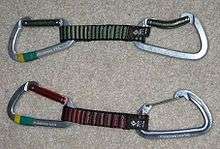Quickdraw

A quickdraw (also known as an extender) is a piece of climbing equipment used by rock and ice climbers to allow the climbing rope to run freely through bolt anchors or other protection while leading. The straight gate carabiner is clipped to the protection; a bent gate is used for the rope.[1]
Use
A quickdraw consists of two carabiners connected by a sewn loop of webbing referred to as a dogbone.[2] These differ in two ways from slings used in traditional climbing: the webbing is sewn through which provides greater rigidity and assists the speed of clipping, and protection from the carabiner clipping itself out of the sling loop in a fall.
Dogbones typically run between 12 centimetres (5 in) and 30 centimetres (12 in) in length. Traditional climbers tend to opt for longer quickdraws, which allow for greater rope movement and thereby reduce the chances of protection becoming dislodged.[3] Shorter, stiffer, easier to clip quickdraws are preferred by sport climbers, who rely on fixed protection and do not have the same concerns about dislodgement.
Assembled quickdraws are available in a wide variety of carabiner styles and sling lengths to suit different applications and tastes. Climbers also assemble their own out of webbing and carabiner combinations adapted to their needs.
References
- ↑ Hattingh, Garth (July 1998). The Climber's Handbook (1 ed.). Stackpole Books. ISBN 0-8117-2706-8.
- ↑ Black Diamond product page (2009-08-05)
- ↑ "Quickdraws". Rock-Climbing-Info.co.uk. 2009. Retrieved 2011-06-07.
External links
- How to select Quickdraws for Climbing
 Media related to Quickdraws at Wikimedia Commons
Media related to Quickdraws at Wikimedia Commons